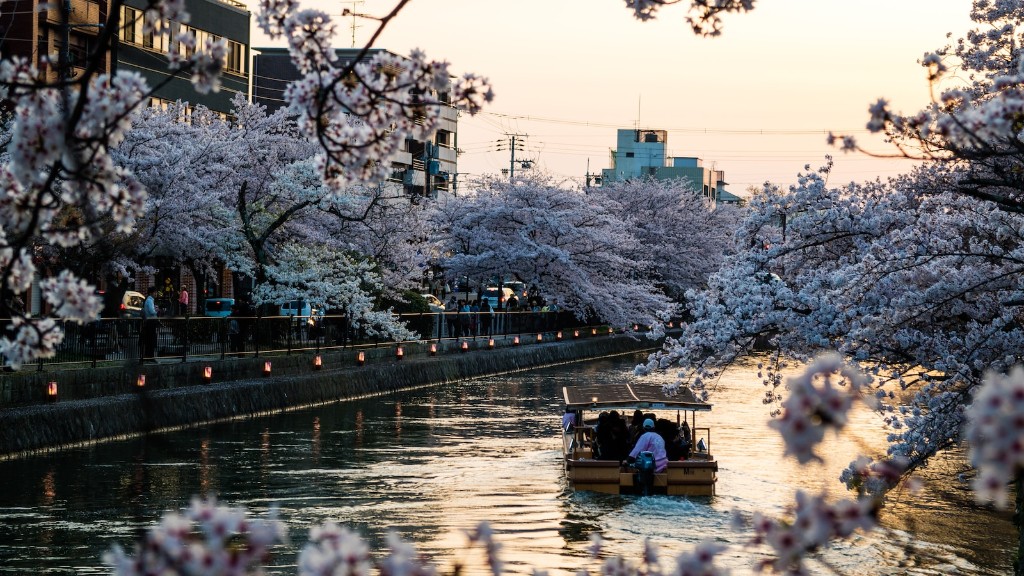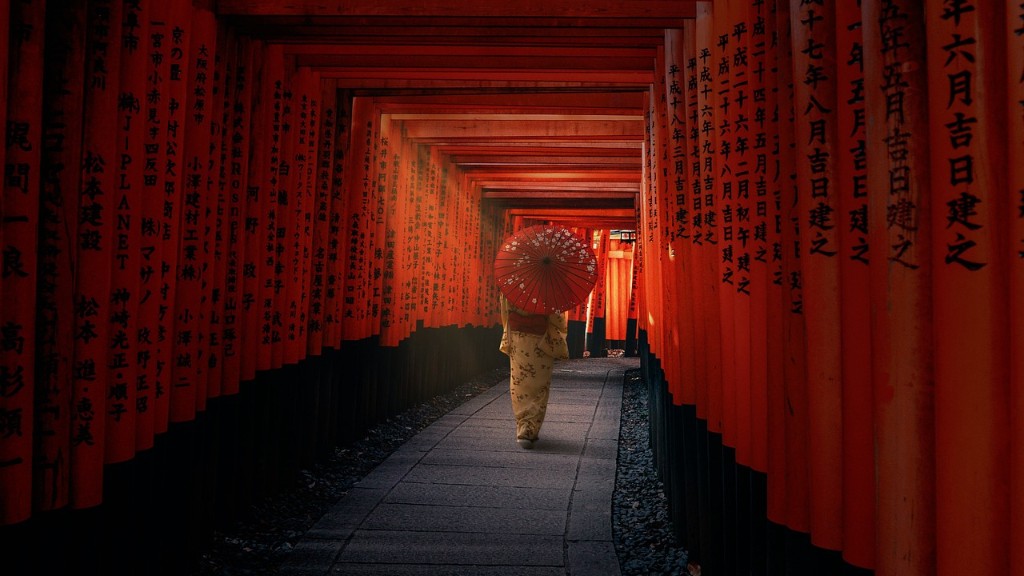Wondering what are those Japanese traveling prayer box mandalas doing in the midst of your travels in Japan? It is an enchanting sight, one of the most iconic symbols in the Japanese Buddhist culture. The traveling prayer box mandala is a religious emblem that floats through Japan, creating a tranquil atmosphere in its movement.
Mandala, Sanskrit for circle, is a powerful and spiritual symbol. Mandalas contain symbols that represent the cyclical nature of existence. A traveling prayer box mandala is a cloth model of this circular wheel of Buddhist wisdom carried in a straw basket. It is believed that anyone who sees it will be blessed with good energy.
The custom of carrying a traveling prayer box mandala is said to have originated in the 1200s, when a monk would carry the mandala and beseech for donations and prayers from households along the route. Afterwards, the baskets were filled with money and prayer requests, and returned to the temple, carried by the same monk. Since then, the practice has evolved into a form of self-expression and appreciation for the divine.
A traveling prayer box mandala is decorated with colorful silk cloths, adorned with portraits of various Buddhist figures such as Bodhisattvas, Buddhas, and Shinto gods. They come in various sizes and colors, with different sizes to fit their purpose and recipient. People from all walks of life in Japan often buy these mandalas and carry it on their travels as a form of protection and ritual offering to the deities.
The beauty of the traveling prayer box mandala is its flexibility. It can take on different forms as it is moved around, making it an unforgettable part of your journey to Japan. Its vibrant colors and detailing can bring joy and harmony to any place it visits, making it a great way to connect with people and local cultures.
A traveling prayer box mandala provides a connection to the divine and its beauty can make a spiritual journey even more meaningful. It is said that the mandala symbolizes peace, contentment and transformation, which makes its presence in Japan an iconic reminder of faith, hope and love.
History of Traveling Prayer box Mandalas
The practice of carrying a traveling prayer box mandala is said to have begun sometime in the 1200s, during the Kamakura period of Japanese history. The custom was believed to have started with a Buddhist monk, who carried the mandala from temple to temple, and sought donations and blessings from the people of each town. After receiving alms and prayers, the monk would return the mandala to the temple with the donations and prayers inside.
The practice of carrying a traveling prayer box mandala soon spread to other regions of Japan, particularly those missing or depleting religious services. It soon became customary to carry a mandala from town to town, and receive donations and blessings before returning it to the temple.
The practice of carrying a traveling prayer box mandala evolved as it spread across Japan, picking up different elements of Buddhism and local cultures along the way. It was said to be a potent symbol of faith and protection, and came to be seen as an offering to deities. Eventually, the practice flourished and moved beyond temples — traveling prayer box mandalas were often seen in households, shrines, and places of business.
Today, the traveling prayer box mandala is still a popular ritual practice in Japan, and is an integral part of traditional Buddhist life. It is a powerful symbol of spiritual growth and harmony, and is a sign to those who encounter it to stay humble, connected to the divine, and aware of interconnectedness.
Traditional and Cultural Significance of Traveling Prayer Box Mandalas
The traditional and cultural significance of the traveling prayer box mandala in Japan is thought to be related to its use as a symbol of protection. It is believed that anyone who encounters the mandala will be blessed with good energy, and is reminded of the importance of living in harmony with nature and others.
In some places, it is believed to possess purifying effects on the one who carries it. This practice is believed to lead to emotional and spiritual healing, and is often used in a ritual to purify the environment. It is believed to signify the protection of the Buddhist community and to ward off evil spirits.
The color and decorations of a traveling prayer box mandala can vary according to the place of origin and its purpose. The most iconic symbol is the five-colored nave, which represents the five Buddhas of the Wisdomking Yamantaka mandala. Other decorations might include sutras, Bodhisattvas, Buddhist deities, and various Buddhist symbols.
There is also a traditional ceremony associated with the traveling prayer box mandala. After being placed in the hands of a recipient, the mandala is blessed with a verse or mantra. Flowers, incense, and bells may also be used depending on the ritual. All together, these are said to give significance to the ceremony and connect the mandala to the divine.
Modern Traveling Prayer Box Mandalas
Today, modern versions of the traditional traveling prayer box mandala can be seen in many places in Japan. It is common to see mandalas at festivals, events and temples, usually made of silk and brightly colored. People often purchase a mandala to show appreciation to the deities, or to carry it on their travels as a form of ritual offering.
These modern mandalas are often decorated with symbols of peace, transformation, and connection, and may also include images of Buddhas, Bodhisattvas, and various Buddhist symbols. The colors of the mandala often have symbolic meanings, with some invoking the power of Amaterasu, Japan’s sun goddess.
The use of traveling prayer box mandalas for spiritual protection is still prevalent today. These mandalas are a reminder of the interconnectedness of all things and the need to lead a humble, mindful, and happy life. They are an integral part of Japanese spiritual and religious life, and are a powerful symbol of faith, hope, and love.
Benefits of Traveling Prayer Box Mandalas
The benefits of traveling prayer box mandalas are numerous. The gesture of carrying a mandala on one’s travels is often seen as a sign of respect for the divine, and is believed to lead to greater spiritual harmony. They are also believed to have numerous practical benefits, such as bringing protection to its carrier, eradicating negative feelings, and warding off evil influences.
Many people believe that carrying a mandala on one’s travels can also bring good luck in the areas of health, wealth, and relationships. A mandala is also said to represent meditative thought and peace, and can have a calming and powerful effect on the mind, body, and spirit.
Ultimately, a traveling prayer box mandala is a reminder of the power of faith and connection to the divine. It is a meaningful way to express gratitude, honor the divine, and show respect for the world at large. It can be a powerful tool in connecting with our inner depths, and for finding contentment and growth in the journey through life.
Upkeep and Maintenance of Traveling Prayer Box Mandalas
It is necessary to take proper care of a mandala in order to keep it in its best condition. Practically speaking, a mandala should be regularly checked for wear and tear, and any damage should be mended as soon as possible. This is important to prevent any further damage, and to ensure that the mantra remains on the mandala.
Additionally, cleanliness is important for the spiritual and physical wellbeing of the mandala. As such, the mandala should be washed regularly in lukewarm water, and left to dry in shade. This is especially important for outdoor ceremonies and rituals, as the exposure to the elements and smoke from incense can take a toll on the material.
It is also important to keep the mantras and symbols in the mandala in good condition. If the mantras are fading, they can be restored by rewriting them anew, using materials such as gold, red ink, or silver particles. As for the symbols, if there is any damage, it can be repaired using a patch or cloth that matches the original.
Conclusion
The traveling prayer box mandala is a beautiful and meaningful tradition in Japan. It is a powerful symbol of faith, hope, and spirituality, and carries a special significance in the spiritual and religious life of Japan. It is a reminder of the interconnectedness of all things, and serves as a beacon of light in times of darkness and uncertainty. It is an integral part of Buddhist culture, and an unforgettable part of anyone’s journey to Japan.





